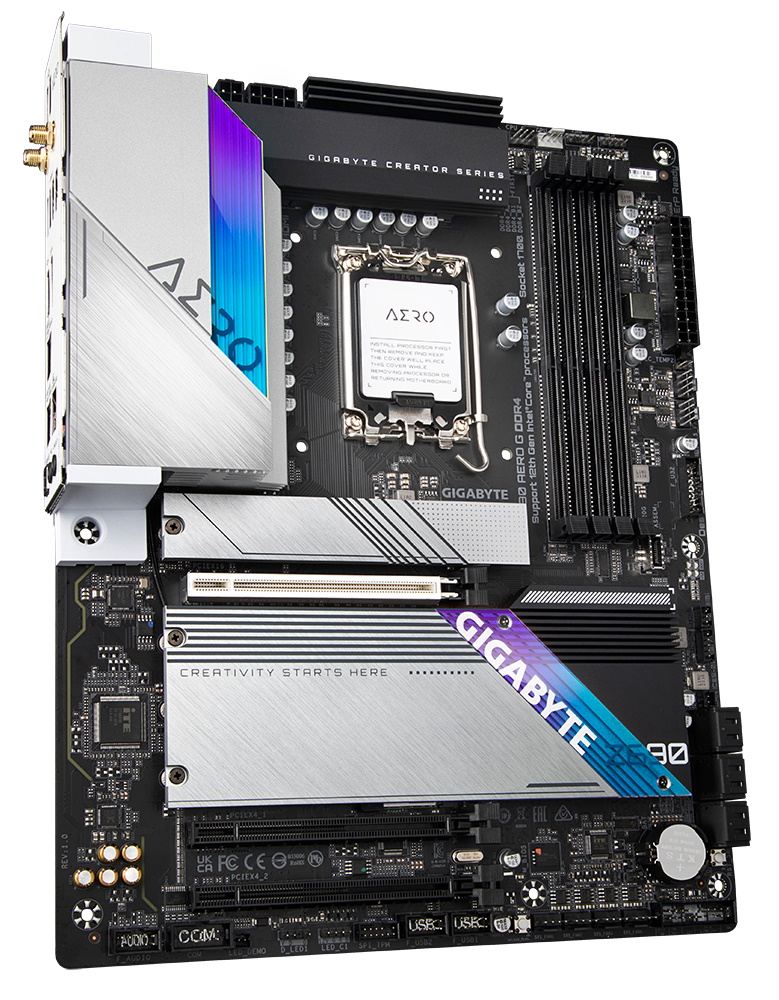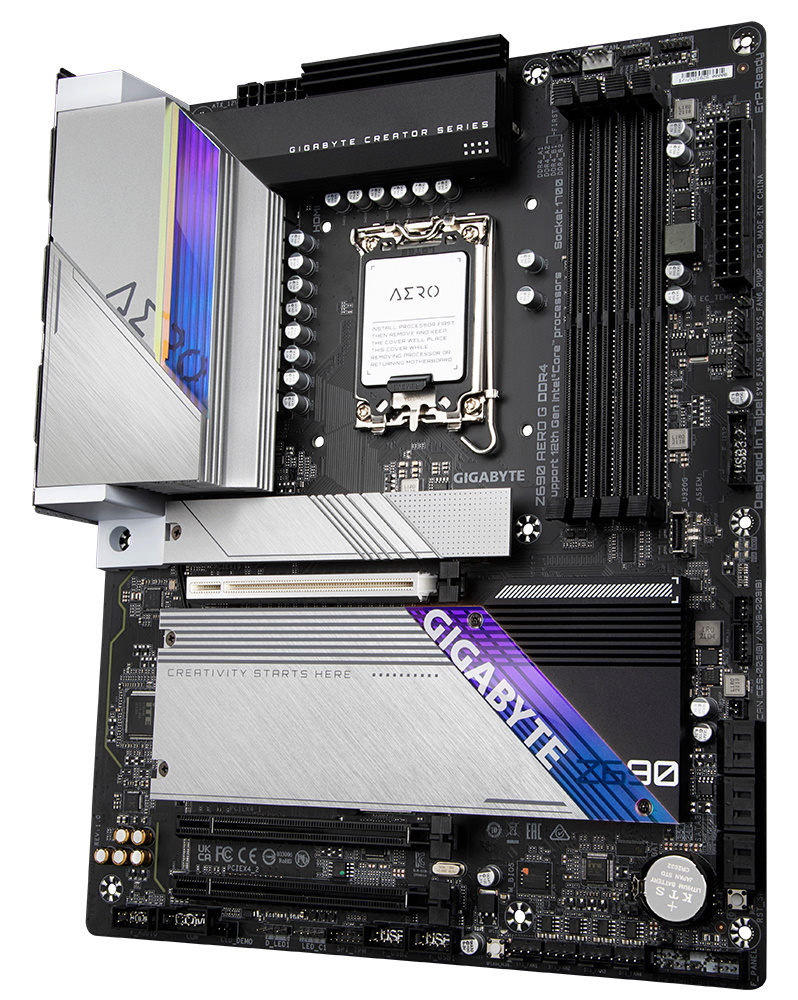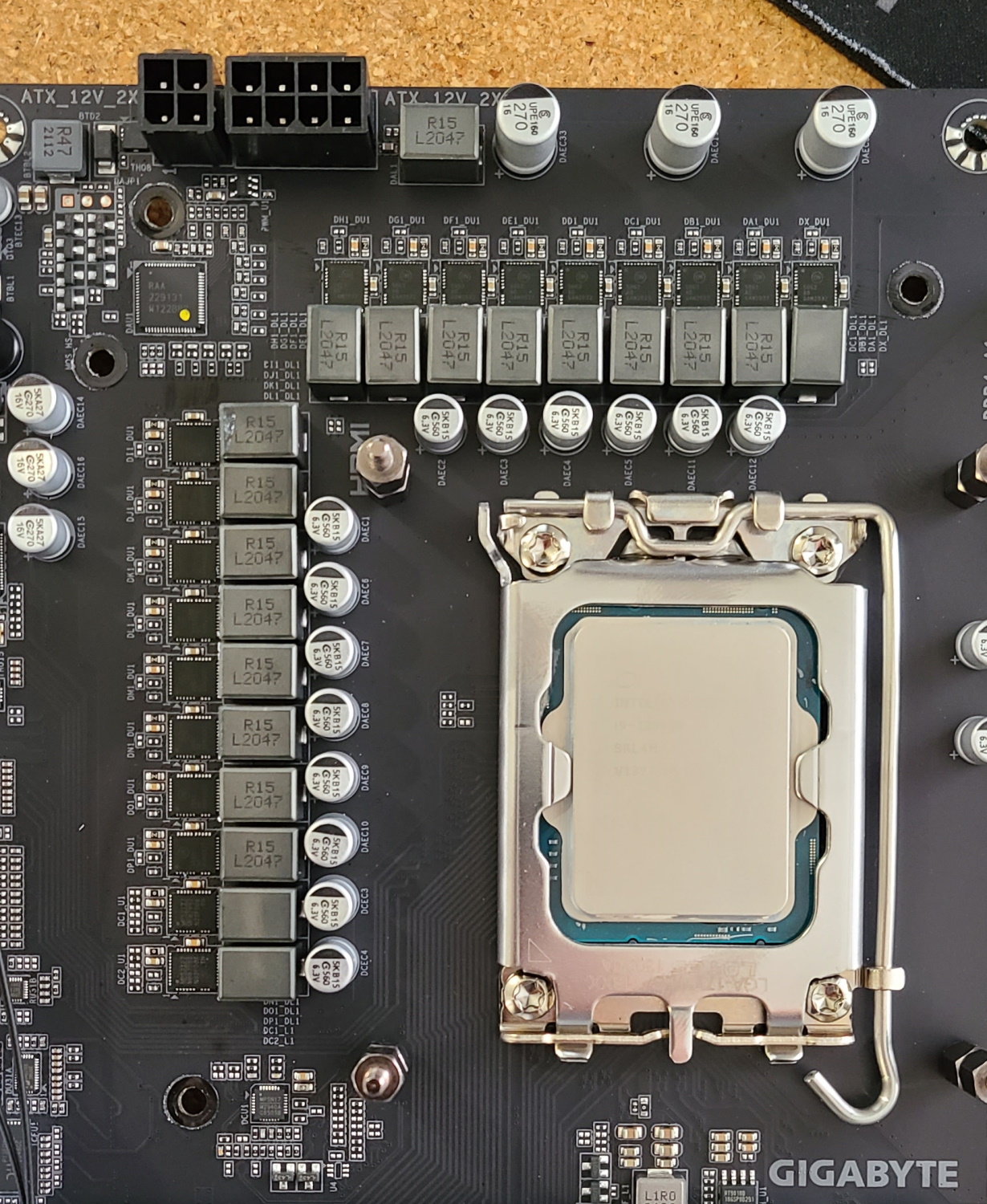Tom's Hardware Verdict
At $289.99, the Gigabyte Z690 Aero G is a viable option for Creators who want Thunderbolt-like VisionLINK functionality. It comes with four M.2 sockets, 2.5 GbE and integrated Wi-Fi 6, an updated appearance and capable power delivery. Even if you can’t use the ViosnLINK IO, the Aero G is still a good lower-priced option.
Pros
- +
+ Thunderbolt-like VisionLINK feature
- +
+ Four M.2 sockets
- +
+ Price
Cons
- -
Vcore overvolts when set manually
- -
Minor performance loss with DDR4
Why you can trust Tom's Hardware
Gigabyte’s Z690 Aero G DDR4 is designed for the Creators looking to get into Intel’s latest platform, without spending a lot of money. The Aero G costs $289.99 and is one of the least-expensive Z690 boards marketed to creators and professional types. The Aero G comes with four M.2 sockets and six SATA ports for ample storage options, plenty of USB ports on the rear IO, the latest Realtek audio codec, 2.5 GbE and integrated Wi-Fi 6, competent power delivery, along with a more professional appearance than many other boards aimed at gamers and overclockers.
Compared to the previous-generation Z590 Vision G, the Z690 version adds more metal, particularly around the VRM area. Gone is the plastic cover over the VRM. Instead you get a large chunk of aluminum that not only looks better but cools better too. Outside of that, there aren’t too many physical changes as the new board keeps the grey/brushed aluminum theme.
Performance on this DDR4-equipped board was similar to the Asus TUF Gaming Z690-Plus WIFI D4 we just looked at. In short, most tests were comparable with DDR5 boards, though some showed significant differences. Between the Aero G and the other DDR4 board we’ve tested, the Aero was negligibly slower. On the memory front, the Aero G ran our DDR4 3600 sticks without issue, though it did default to Gear 2 with some very high latency. Gear 1 worked flawlessly when enabled. It also ran our DDR4 4000 sticks by simply enabling the XMP profile. Read on for much more, including overclocking and any features that set this board apart from others. Before we share what happened with our testing, here’s a complete list of the Gigabyte Z690 Aero G DD4 specifications from Gigabyte.
Specifications - Gigabyte Z690 Aero G DDR4
| Socket | LGA1700 |
| Chipset | Z690 |
| Form Factor | ATX |
| Voltage Regulator | 16 Phase (16+1+2, 70A MOSFETs for Vcore) |
| Video Ports | (1) USB Type-C (via VisionLINK) |
| Row 5 - Cell 0 | (1) HDMI (v2.1) |
| Row 6 - Cell 0 | (1) DisplayPort (Input - v1.4) |
| USB Ports | (1) USB 3.2 Gen 2x2 Type-C ports (20 Gbps) |
| Row 8 - Cell 0 | (1) USB 3.2 Gen 1 Type-C port (5 Gbps) |
| Row 9 - Cell 0 | (2) USB 3.2 Gen 2 (10 Gbps) |
| Row 10 - Cell 0 | (4) USB 3.2 Gen 1 (5 Gbps) |
| Row 11 - Cell 0 | (2) USB 2.0 (480 Mbps) |
| Network Jacks | (1) 2.5 GbE |
| Audio Jacks | (2) Analog + SPDIF |
| Legacy Ports/Jacks | ✗ |
| PCIe x16 | (1) v. 5.0 (x16) |
| Row 16 - Cell 0 | (2) v. 3.0 (x4) |
| PCIe x8 | ✗ |
| PCIe x4 | ✗ |
| PCIe x1 | ✗ |
| CrossFire/SLI | AMD Quad-GPU CrossFire and 2-Way Crossfire |
| DIMM slots | (4) DDR4 5333+(OC), 128GB Capacity |
| M.2 slots | (3) PCIe 4.0 x4 (64 Gbps) / PCIe (up to 110mm) |
| Row 23 - Cell 0 | (1) PCIe 4.0 x4 (64 Gbps) / PCIe + SATA (up to 110mm) |
| U.2 Ports | ✗ |
| SATA Ports | (6) SATA3 6 Gbps (Supports RAID 0/1/5/10) |
| USB Headers | (1) USB v3.2 Gen 2x2, Type-C (20 Gbps) |
| Row 27 - Cell 0 | (1) USB v3.2 Gen 1 (5 Gbps) |
| Row 28 - Cell 0 | (2) USB v2.0 (480 Mbps) |
| Fan/Pump Headers | (8) 4-Pin (CPU, WaterCPU, System, System/Pump fans) |
| RGB Headers | (2) aRGB Gen2 (3-pin) |
| Row 31 - Cell 0 | (2) RGB (4-pin) |
| Diagnostics Panel | Q-LEDs |
| Internal Button/Switch | Reset button |
| SATA Controllers | ✗ |
| Ethernet Controller(s) | (1) Intel I225-V (2.5 Gbps) |
| Wi-Fi / Bluetooth | Intel AX201 Wi-Fi 6 (2x2 ax, MU-MIMO, 2.4/5/6 GHz, 160 MHz, BT 5.2) |
| USB Controllers | ASMedia ASM1074, ASM3242 |
| HD Audio Codec | Realtek ALC4080 |
| DDL/DTS Connect | ✗ / ✗ |
| Warranty | 3 Years |
After opening the box and taking the board out, you’ll find several accessories stashed away under a cardboard partition. It comes with all of the basics to get you started, but not much more. Surprisingly our sample didn’t include a driver disk/DVD, so you’ll have to get those from the Gigabyte website. Below is a list of everything included with the Aero G.
- (2) SATA 6Gb/s cables
- Wi-Fi antenna
- (4) M.2 screws
- Microphone
- User Manual



I was pleasantly surprised with how the appearance of this board had changed at first glance. The distinct Aero/Vision look remains, with the black and silver theme on the heatsinks. On the VRM heatsink, you’ll find Gigabyte and Aero branding, along with a premium brushed aluminum finish. The M.2 and chipset heatsink has the same black/silver contrast as the VRM heatsinks, giving the areas a nice contrast. If you want integrated RGB lighting, you’ll have to look elsewhere or use the headers found on the board. Overall I like the new look. It doesn’t call attention to itself, yet is still capable of being the centerpiece of your build.
Focusing on the top half of the board, we get a better look at the oversized heatsinks and the Aero branding. There’s a strip with a rainbow/color-changing strip giving the board a bit of bling outside of the black, white and silver that covers the majority of the board. The heatsinks are heavily grooved, which increases surface area and cooling ability. Above the VRM heatsinks are two EPS connectors feeding power to the processor. The first is a required 8-pin and the second is an optional 4-pin.
To the right of the socket are four double-side locking DRAM slots that support up to 128GB of RAM at speeds listed to DDR4 5333+(OC). As always, your mileage may vary in reaching these speeds, as it depends on the quality of the CPU’s memory controller and the kit you use.
Get Tom's Hardware's best news and in-depth reviews, straight to your inbox.
The first two (of eight total) 4-pin fan headers are located just above the DRAM slots. All headers support both DC and PWM-controlled fans, with each one supporting up to 2A/24W. There’s plenty of power for your fans, AIO, and even a water pump. Off to the right are the first RGB headers. There’s a 3-pin ARGB and 4-pin RGB, with the other two located across the bottom edge.
Along the right edge, working our way up from top to bottom, we run into the 24-pin ATX connector to power the board, two system fan headers, a 2-pin header for a temperature probe, and two more fan headers (Pump and System). There’s also a front-panel USB 3.2 header and USB 3.2 Gen 2x2 Type-C front panel header. Also in this area are the four Q-LEDs that light up during POST. If the system runs into an issue, the area where the problem is remains lit. Since the Aero G doesn’t have the more informative 2-character debug LED, you’ll have to rely on this high-level information if you have boot issues.
The Aero G is configured with a 19-phase VRM with 16 phases dedicated to Vcore. Power comes from the EPS connector(s) to a Renesas RAA229131 20-phase controller and then to the OnSemiconductor 70A MOSFETs. The 1,120 Amps available certainly isn’t one of the higher values we’ve come across, but it handled our Intel Core i9-12900K when it was at stock speeds and overclocked without concern.
Shifting focus to the bottom half of the board, we’ll work left to right and start with the audio. In the fully exposed audio section, you’ll find the latest generation Realtek ALC4080 audio codec, along with several Nippon audio capacitors. I was pleasantly surprised to see a high-end audio codec in use for a board that’s priced under $300.
In the middle of the board, we’ll start with the PCIe slots. The Z690 Aero G has a total of three full-length slots. The top slot (white) is reinforced and is the only PCIe 5.0 x16 capable. The bottom two full-length slots (black) source their PCIe 3.0 x4 lanes from the chipset. If you’re still into multi-GPU technologies, this configuration supports AMD Quad GPU CrossFire and 2-Way AMD CrossFire.
Located above and between PCIe slots are four M.2 sockets. The top socket, M2A_CPU, connects directly to the CPU and runs up to PCIe 4.0 x4 (64 Gbps) speeds while supporting up to 110mm drives. M2P_SB and M2Q_SB also run PCIe 4.0 x2 and support 110mm drives. Finally, the last slot, M2M_SB, supports both SATA and PCIe-based modules up to 110mm. There’s plenty of fast M.2 storage available on the Aero G.
Moving right over the chipset to the board’s edge, we run into Thunderbolt AIC headers and six SATA ports. When M.2 socket M2M_SB is used with a PCIe-based SSD, SATA ports 2/3 are disabled. The worst-case scenario for storage is when you run four PCIe-based M.2 SSDs, you’ll have four SATA ports (instead of six) available. If you don’t want to lose any SATA ports, run a SATA-based M.2 module on M2M_SB, leaving three M.2 sockets for PCIe-based modules and all six SATA ports. The Aero G supports RAID0/1/5/10 modes on the SATA ports.
Across the bottom edge of the motherboard are several headers, including USB, SATA ports, and RGB. Here’s the complete list, from left to right:
- Front panel audio
- COM port
- 3-pin ARGB header
- 4-pin RGB header
- TPM header
- (2) USB 2.0 headers
- Q-Flash Plus button
- 4-pin System Fan headers
- Clear CMOS jumper
- Front panel header
Swinging back to the rear IO area, we’ve got a pre-installed IO plate that matches the Aero’s theme. It has a white background with black writing, so the port information is easy to read. There are 10 total USB ports around the back: two USB 3.2 Type-C ports (20 Gbps and 10 Gbps), two USB 3.2 Gen 2 (10 Gbps) ports, four USB 3.2 Gen 1 (5 Gbps) ports and two USB 2.0 (480 Mbps) ports. The eight USB Type-A ports should be enough for most users. For video, you can use the HDMI out or the VisionLINK Type-C port. A DisplayPort port is also found on the rear IO and used as an input. Additionally, you’ll find the 2.5 GbE port, Wi-Fi antenna connections, and finally, a 3-plug plus SPDIF audio stack.
MORE: Best Motherboards
MORE: How To Choose A Motherboard
MORE: All Motherboard Content

Joe Shields is a staff writer at Tom’s Hardware. He reviews motherboards and PC components.
-
-Fran- The fine print on Z690 no one seems to care enough to publish and test:Reply
CPU:
1 x M.2 connector (Socket 3, M key, type 2260/2280/22110 PCIe 4.0 x4/x2 SSD support) (M2A_CPU)Chipset:
2 x M.2 connectors (Socket 3, M key, type 2260/2280/22110 PCIe 4.0 x4/x2 SSD support) (M2P_SB, M2Q_SB)
1 x M.2 connector (Socket 3, M key, type 2260/2280/22110 SATA and PCIe 4.0 x4/x2 SSD support) (M2M_SB)
6 x SATA 6Gb/s connectorsSupport for RAID 0, RAID 1, RAID 5, and RAID 10
* Refer to "2-7 Internal Connectors," for the installation notices for the M.2 and SATA connectors.
Intel® Optane™ Memory Ready
* System acceleration with Intel® Optane™ Memory can only be enabled on the M.2 connectors supported by the Chipset.
You'll get full PCIe4 speeds with just one NVMe as it's using the CPU link, but the rest use the DMI and sATA connector's allocated bandwidth to keep up. Also shared with the USB3 bandwidth provided (why some boards come with less USB3 full-speed links).
Not necessarily a deal-breaker, but it irks me when it's not mentioned anywhere.
Regards. -
daeros I just want to be sure we’re all aware this is an article for a consumer CPU line (not HEDT, workstation, or sever) without support for the new costly DDR5, that costs $300 and gets the label ‘budget’.Reply
More quality journalism from Tom’s “just buy it” Hardware. -
VforV How things have gotten when $290 motherboards are now considered "cheap"... LMAO.Reply
Just because there are $600 or more motherboards made for those that are , that does not mean $300 is cheap.
Pathetic, both these prices and the articles that promote such things as "cheap". -
Co BIY I guess I'm worn down to accept the "new normal" of $300 budget motherboards. But I'm just looking not buying.Reply
I think the DDR5 / DDR4 problem is holding back Alder Lake.
To invest in a new motherboard and processor I want all the generational improvements.
DDR5 right now is overpriced and still only a marginal improvement over DDR4. Why buy into it now?
Still interested in seeing a review of the EVGA P6 PSU. -
samopa Reply-Fran- said:Support for RAID 0, RAID 1, RAID 5, and RAID 10
* Refer to "2-7 Internal Connectors," for the installation notices for the M.2 and SATA connectors.
Intel® Optane™ Memory Ready
* System acceleration with Intel® Optane™ Memory can only be enabled on the M.2 connectors supported by the Chipset.
You'll get full PCIe4 speeds with just one NVMe as it's using the CPU link, but the rest use the DMI and sATA connector's allocated bandwidth to keep up. Also shared with the USB3 bandwidth provided (why some boards come with less USB3 full-speed links).
Not necessarily a deal-breaker, but it irks me when it's not mentioned anywhere.
In my Z690 Aorus Master (similar config with this mobo), I'm using 3 x 980 Pro in RAID 0, all of them connected to the chipset (not direct to CPU) , I have got 14100 MB/s write speed (out of 15000 MB/s theoretical of 3 x 5000 MB/s 980 Pro capability) using CrystalDisk Benchmark on Queue Depth (QD) 8, and 12600 MB/s using QD2.
These facts say that connecting SSD to the Chipset (instead of direct to CPU) give negligible effects. -
-Fran- Reply
That's good and all, but benching you're testing best scenario. are you using the USB ports and other significant I/O?samopa said:In my Z690 Aorus Master (similar config with this mobo), I'm using 3 x 980 Pro in RAID 0, all of them connected to the chipset (not direct to CPU) , I have got 14100 MB/s write speed (out of 15000 MB/s theoretical of 3 x 5000 MB/s 980 Pro capability) using CrystalDisk Benchmark on Queue Depth (QD) 8, and 12600 MB/s using QD2.
These facts say that connecting SSD to the Chipset (instead of direct to CPU) give negligible effects.
Also, how are the random accesses?
Regards. -
g-unit1111 This might seem like a dumb question but what's the difference between a "creator" board and a "gamer" board? Is it just marketing terminology or is it something else?Reply -
samopa Reply-Fran- said:That's good and all, but benching you're testing best scenario. are you using the USB ports and other significant I/O?
I'm using 10GbE connection to my Asus 10GbE Switch and using Razer Ripsaw X to my USB 3.2 Ports.
-Fran- said:Also, how are the random accesses?
Around 1300 MB/s at QD8 and 500 MB/s at QD2 -
-Fran- Reply
That reads normal at least. As I expected, random access won't saturate even 1 PCIe4 link still.samopa said:I'm using 10GbE connection to my Asus 10GbE Switch and using Razer Ripsaw X to my USB 3.2 Ports.
Around 1300 MB/s at QD8 and 500 MB/s at QD2
I wonder what will happen when you use more USB ports and other drives. I have 4 disks with one NVMe, plus 8 USB devices pluggd in all the time and usin just a 1Gbps LAN. Also, some BT devices connected. So I'm using a lot of that uplink from the SB to the CPU in multiple things. I don't know how to measure the "saturation", but at times some USB devices don't work at full speed, so that's where I'm coming from. I'm on a X470 chipset though.
Regards. -
samopa Reply-Fran- said:I wonder what will happen when you use more USB ports and other drives. I have 4 disks with one NVMe, plus 8 USB devices pluggd in all the time and usin just a 1Gbps LAN. Also, some BT devices connected. So I'm using a lot of that uplink from the SB to the CPU in multiple things. I don't know how to measure the "saturation", but at times some USB devices don't work at full speed, so that's where I'm coming from. I'm on a X470 chipset though.
I have 3 WDC Gold 12TB installed in RAID5 configuration, I also had a Seagate FireCuda 2TB SSD in USB Type C external casing that I'm used to store my data files when I'm visiting my client's office. I also have Logitech Brio 4K for my zoom meeting and a WDC Black 4TB in e-SATA port for data backup.



